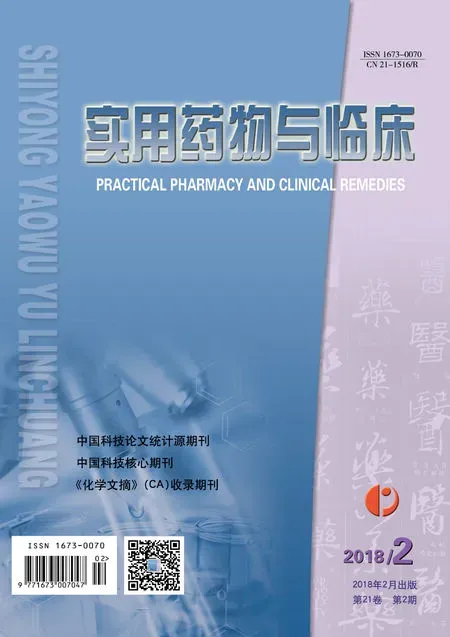替诺福韦艾拉酚胺治疗慢性乙型肝炎的临床应用及研究进展
2018-03-18邱新野朱晓虹张月宁张世斌王咏梅
邱新野,朱晓虹,尹 月,张月宁,张世斌,王咏梅*
0 引言
2016年10月,美国FDA (Food and Drug Administration)批准替诺福韦艾拉酚胺(Tenofovir alafenamide,TAF)用于治疗成人慢性乙型肝炎,其规格为25 mg (相当于28 mg半富马酸替诺福韦艾拉酚胺)。说明书推荐该药常规给药剂量:每次25 mg,每日1次,与食物同时服用[1]。该药也是近10年来美国FDA批准的唯一治疗慢性乙型肝炎的新药。2017年欧洲肝病学会(EASL)更新的《2017年欧洲肝病学会临床实践指南:HBV感染的管理》,也首次将TAF与恩替卡韦(ETV)、替诺福韦酯(TDF)并列为治疗慢性乙型肝炎的首选药物[2]。
1 TAF的作用机制及药效学特点
TAF是依赖RNA的DNA聚合酶抑制剂,是替诺福韦(TFV)的口服前药,与替诺福韦酯(TDF)相似。TAF通过肝摄取转运蛋白进入肝细胞后,被羧酸酯酶1(CES1)水解,转换成TFV,而起到抑制病毒复制的作用,由于CES1在肝脏中是高表达的[3],所以TAF对抑制乙肝病毒的复制具有一定的靶向作用[4]。体外实验数据显示,TAF 25 mg的抗病毒作用与TDF 300 mg的抗病毒作用无明显差异。Murakami等[4]将人原肝细胞分别加入5 μmol/L的TAF、TDF和TFV溶液,并进行24 h体外孵育实验,采用LC-MS/MS法分别测定第0、4、8、24小时孵育体系中肝细胞内替诺福韦二磷酸盐(TFV-DP)的浓度。结果显示,孵育24 h后TAF孵育体系中TFV-DF的浓度分别是TFV和TDF的120倍和5倍[5],间接说明相同给药剂量时,TAF表现出来的抑制病毒复制的活性是最强的。也正是由于TAF在药代动力学和药效上的优点,使得其给药剂量远远低于TDF,因此,TAF的安全性较高,对肾和骨骼的毒性较小。
2 TAF的临床研究
2.1 48周的Study108研究和Study110研究 关于TAF的Ⅲ期临床研究[6],研究对象为慢性乙型肝炎患者(除外肝硬化患者),HBeAg阴性患者纳入Study108研究(425例),HBeAg阳性患者纳入Study110研究(873例),采取随机、双盲、对照的研究方法,共进行48周的临床研究,研究过程中受试者除了接受TAF治疗外,不允许接受任何其他药物的治疗。
Study108研究中,纳入的425例HBeAg阴性的初治或经治慢性乙型肝炎患者,以2∶1的比例随机接受TAF 25 mg/d (285例)或TDF 300 mg/d (140例)的治疗。第48周数据显示,TAF组血清HBV DNA水平<29 IU/mL的患者比例为94.0% (268/285),TDF组的比例为92.9% (130/140),达到了非劣效性试验的主要终点(95%CI:-3.6%~7.2%,P=0.47)。
Study110研究中,纳入的873例HBeAg阳性的初治或经治慢性乙型肝炎患者,同样以2∶1的比例随机接受TAF 25 mg/d (581例)或TDF 300 mg/d (292例)的治疗,通过第48周的数据显示,TAF组血清HBV DNA水平<29 IU/mL的患者比例为63.9% (371/581),TDF组的比例为66.8% (195/292),同样达到了非劣效性试验的主要终点(95%CI:-9.8%~2.6%,P=0.25)。
以HBsAg和HBeAg的转阴率或血清学转换率为研究观察终点的数据显示,Study110研究(HBeAg阳性组)中,TAF组的HBeAg转阴率及血清学转换率的比例分别为14%和10%,HBsAg转阴率及血清学转换率的比例均为1%;而TDF组的HBeAg转阴率及血清学转换率的比例则分别为12%和8%,HBsAg转阴率<1%,血清学转换率则为0。另外,在研究第48周时,TAF组ALT复常率为83%(n=285),而TDF组为75% (n=140),略低于TAF组。通过对不同研究终点的数据进行分析发现,TAF均具有显著的治疗效果,与TDF相比较差异无统计学意义。
2.2 96周的Study108研究和Study110研究[7]关于Study108研究和Study110研究第96周的结果显示,TAF治疗慢性乙型肝炎较TDF有优势。
Study110研究结果显示,TAF组治疗HBeAg阳性的慢性乙型肝炎患者96周时,患者病毒学应答率为73% (423/581),HBeAg转阴率和HBeAg血清学转换率分别为22%和18%,但仅有1%的患者获得了HBsAg转阴[8];TDF组治疗96周时病毒学应答率为75% (218/292)。
Study108研究结果显示,治疗HBeAg阴性慢性乙型肝炎患者96周时,TAF组病毒学应答率为90% (257/285),但仅有1例(<1%) 获得了HBsAg转阴[9];TDF组病毒学应答率为91% (127/140)。
另外,通过这两项临床研究还观察到,无论是基于美国肝病协会(AASLD)的检验标准还是美国中央实验室的检验标准,相对于使用TDF治疗的患者,使用TAF治疗的患者96周时ALT复常率为75%,高于TDF组的68%。在观察第96周发现,与使用TDF治疗的患者相比,使用TAF治疗的患者在肾功能及骨骼方面的获益是有优势的,与研究基线相比较,TAF较少影响患者的臀部和脊柱的骨密度以及患者的肌酐清除率。在96周的观察周期中,两组几乎均没有患者因为无法耐受不良反应而终止治疗,且两组患者在观察的第96周时,均未发生HBV病毒耐药的现象。
在一项回顾性分析中,对参与了Study108研究和Study110研究,且已经完成96周双盲研究的541例患者,无论是既往接受TAF还是TDF治疗的患者,均采取非盲的试验方法,全部使用TAF治疗,继续观察96周,其中包括既往使用TDF的患者180例。通过96周的观察,结果显示,这180例患者依然获得病毒学应答,另外,无论是基于美国肝病协会(AASLD)的检验标准还是美国中央实验室的检验标准,这180例转换接受TAF治疗的患者,在使用TAF治疗的24周后,ALT均恢复至正常水平。在骨密度和肌酐清除率获益方面,这180例患者的臀部和脊柱骨密度以及肌酐清除率均得到显著改善。
虽然以上数据证实TAF相较于TDF在某些方面有一定优势,但依然需要长期的观察及大量的数据支持。
3 TAF的安全性评价
TDF作为治疗慢性乙型肝炎的首选药物之一[10-11],常见的不良反应为引起慢性肾小管损伤、肾功能异常和骨密度下降[12-13],且有引起Fanconi综合征而改为ETV治疗的病例报告[14-22]。而在2017年刚刚被ESAL推荐为治疗慢性乙型肝炎首选药物之一的TAF,相较于TDF在相关的临床研究中则表现出更好的疗效和安全性[23-25]。临床研究中就蛋白尿和磷酸盐排泄异常发生率方面的数据显示,TAF组比TDF组更低,说明TAF组更不易造成肾脏损伤[25]。另有注册研究显示,无论是HBeAg阳性还是HBeAg阴性的慢性乙型肝炎患者,TAF治疗48周和96周时,对肾功能和骨转换等指标影响的发生率均显著低于TDF。
4 TAF的临床使用
根据TAF的相关研究建议,有轻度、中度或重度肾功能损害的患者无需调整使用剂量,而ETV和TDF则需要根据患者的肾功能调整使用剂量,但TAF不推荐处于终末期肾脏疾病的患者(肌酐清除率低于15 mL/min)使用。对于轻度肝损伤患者,使用TAF时不需要调整使用剂量,而对于肝硬化失代偿期的患者,使用TAF的安全性和有效性目前尚未确定,故不建议肝硬化失代偿(Child-Pugh B或C)患者使用该药[1]。
根据《2017年欧洲肝病学会临床实践指南:HBV感染的管理》推荐[2],以下人群治疗慢性乙型肝炎建议首选TAF或ETV而非TDF:①年龄>60岁患者;②骨病患者,例如长期应用皮质类固醇或其他可引起骨密度降低的药物,脆性骨折史者,骨质疏松症者等;③肾功能不全患者,如eGFR<60 mL/min,尿中白蛋白>30 mg,血磷<2.5 mg/dL及血液透析者。当eGFR<50 mL/min且≥15 mL/min时,ETV和TDF均应调整剂量使用,而TAF则可以维持25 mg/d剂量不变[26]。另外,指南还推荐接受ETV、TDF或TAF治疗时出现部分病毒学应答的患者,多与治疗前极高的病毒载量相关,而非药物抗病毒能力不足。治疗48周部分病毒学应答的患者,若其HBV DNA水平呈进行性下降,可应用同一药物继续治疗;若HBV DNA水平并未进行性下降,应建议转换为另一种药物或联合治疗选择ETV+TDF/TAF,这对进展性肝病患者尤为重要。
5 结语
综上所述,TAF作为治疗慢性乙型肝炎的一线药物,由于其使用剂量远远低于TDF,所以其不良反应的发生率较TDF明显降低,但临床疗效与TDF相当,甚至部分研究显示,其血清HBV DNA的转阴率,HBsAg和HBeAg的转阴率或血清学转换率还略高于TDF。对于年龄大于60岁,骨病及肾功能异常患者,TAF被推荐为治疗慢性乙型肝炎的首选药物。
[1] FDA.Vemlidy 说明书[EB/OL].http://www.accessdata.fda.gov/drugsatfda_docs/label/2016/208464s000lbl.pdf.
[2] European Association for the Study of the Liver.EASL 2017 Clinical Practice Guidelines on the management of hepatitis B virus infection[J].J Hepatol,2017.[Epub ahead of print]
[3] Williams ET,Bacon JA,Bender DM,et al.Characterization of the expression and activity of carboxylesterases 1 and 2 from the beagle dog,cynomolgus monkey,and human[J].Drug Metabol Dispos,2011,39(12):2305-2313.
[4] Murakami E,Wang T,Park Y,et al.Implications of efficient hepatic delivery by tenofovir alafenamide(GS-7340)for hepatitis B virus therapy[J].Antimicrob Agents Chronicle,2015,59(6):3563-3569.
[5] Delaney WE,Ray AS,Yang H,et al.Intracellular metabolism and in vitro activity of tenofovir against hepatitis B virus[J].Antimicrob Agents Chemother,2006,50(7):2471-2477.
[6] Gilead:two phase 3 studies evaluating tenofovir alafenamide (taf) for patients with chronic hepatitis B infection[EB/OL].[2016-01-27].http://www.businesswire.com/news/home/20160105005560/en/.
[7] International liver congress 2017:efficacy and safety of vemlidy in patients with chronic hepatitis B after 96 weeks,and also after switching from viread[EB/OL].[2017-04-20].http://www.businesswire.com/news/home/2017042000 5335/en/.
[8] Mazzarelli C,Cannon MD,Belli LS,et al.Direct-acting antiviral therapy in patients with hepatocellular cancer:the timing of treatment is everything[J].J Hepatol,2017.
[9] Brunetto M,Lim YS,Gane E,et al.A phase 3 study comparing tenofovir alafenamide (TAF) to tenofovir disoproxil fumarate (TDF) in patients with HBeAg-negative,chronic hepatitis B (CHB):efficacy and safety results at week 96[J].J Hepatol,2017,66:S25-S26.
[10]Pol S,Lampertico P.First-line treatment of chronic hepatitis B with entecavir or tenofovir in‘real-life’settings:from clinical trials to clinical practice[J].J Viral Hepatitis,2012,19(6):377-386.
[11]Chang BW,Kaung A,Robbins L,et al.Hepatitis B:working towards a cure[J].Curr Gastroenterol Reports,2015,17(9):35-39.
[12]Tien C,Xu JJ,Chan LS,et al.Long-term treatment with tenofovir in Asian-American chronic hepatitis B patients is associated with abnormal renal phosphate handling[J].Dig Dis Sci,2015,60(2):566-572.
[13]Aurpibul L,Cressey TR,Sricharoenchai S,et al.Efficacy,safety and pharmacokinetics of tenofovir disoproxil fumarate in virologic-suppressed HIV- infected children using weightband dosing[J].Pedia Infect Disease J,2015,34 (4):392-397.
[14]Lampertico P,Chan HL,Janssen HL,et al.Review article:long-term safety of nucleoside and nucleotide analogues in HBV-monoinfected patients[J].Aliment Pharmacol Ther,2016,44(1):16-34.
[15]Gill US,Zissimopoulos A,Al-Shamma S,et al.Assessment of bone mineral density in tenofovir-treated patients with chronic hepatitis B:can the fracture risk assessment tool identify those at greatest risk[J].J Infect Dis,2015,211(3):374-382.
[16]Maggi P,Montinaro V,Leone A,et al.Bone and kidney toxicity induced by nucleotide analogues in patients affected by HBV-related chronic hepatitis:a longitudinal study[J].J Antimicrob Chemother,2015,70(4):1150-1154.
[17]Fung S,Kwan P,Fabri M,et al.Tenofovir disoproxil fumarate (TDF) vs.emtricitabine (FTC)/TDF in lamivudine resistant hepatitis B:a 5-year randomised study[J].J Hepatol,2017,66(1):11-18.
[18]Buti M,Tsai N,Petersen J,et al.Seven-year efficacy and safety of treatment with tenofovir disoproxil fumarate for chronic hepatitis B virus infection[J].Dig Dis Sci,2015,60(5):1457-1464.
[19]Han Y,Zeng A,Liao H,et al.The efficacy and safety comparison between tenofovir and entecavir in treatment of chronic hepatitis B and HBV related cirrhosis:a systematic review and Meta-analysis[J].Int Immunopharmacol,2017,42:168-175.
[20]Ahn J,Lee HM,Lim JK,et al.Entecavir safety and effectiveness in a national cohort of treatment-naïve chronic hepatitis B patients in the US-the ENUMERATE study[J].Aliment Pharmacol Ther,2016,43(1):134-144.
[21]Law ST,Lee MK,Li KK,et al.Comparison of efficacy and renal safety of telbivudine and entecavir in treatment-naive elderly patients with chronic hepatitis B[J].Eur J Gastroenterol Hepatol,2016,28(2):193-198.
[22]Coppolino G,Simeoni M,Summaria C,et al.The case of chronic hepatitis B treatment with tenofovir:an update for nephrologists[J].J Nephrol,2015,28(4):393-402.
[23]Sax PE,Wohl D,Yin MT,et al.Tenofovir alafenamide versus tenofovir disoproxil fumarate,coformulated with elvitegravir,cobicistat,and emtricitabine,for initial treatment of HIV-1 infection:two randomised,double-blind,phase 3,non-inferiority trials[J].Lancet,2015,385(9987):2606-2615.
[24]Mills A,Arribas JR,Andrade-Villanueva J,et al.Switching from tenofovir disoproxil fumarate to tenofovir alafenamide in antiretroviral regimens for virologically suppressed adults with HIV-1 infection:a randomised,active-controlled,multicentre,open-label,phase 3,non-inferiority study[J].Lancet Infect Dis,2016,16(1):43-52.
[25]Wohl D,Oka S,Clumeck N,et al.Brief report:a randomized,double-blind comparison of tenofovir alafenamide versus tenofovir disoproxil fumarate,each coformulated with elvitegravir,cobicistat,and emtricitabine for initial HIV-1 treatment:week 96 results[J].J Acquir Immune Defic Syndr,2016,72(1):58-64.
[26]Chan HL,Fung S,Seto WK,et al.Tenofovir alafenamide versus tenofovir disoproxil fumarate for the treatment of HBeAg-positive chronic hepatitis B virus infection:a randomised,double-blind,phase 3,non-inferiority trial[J].Lancet Gastroenterol Hepatol,2016,1(3):185-195.
